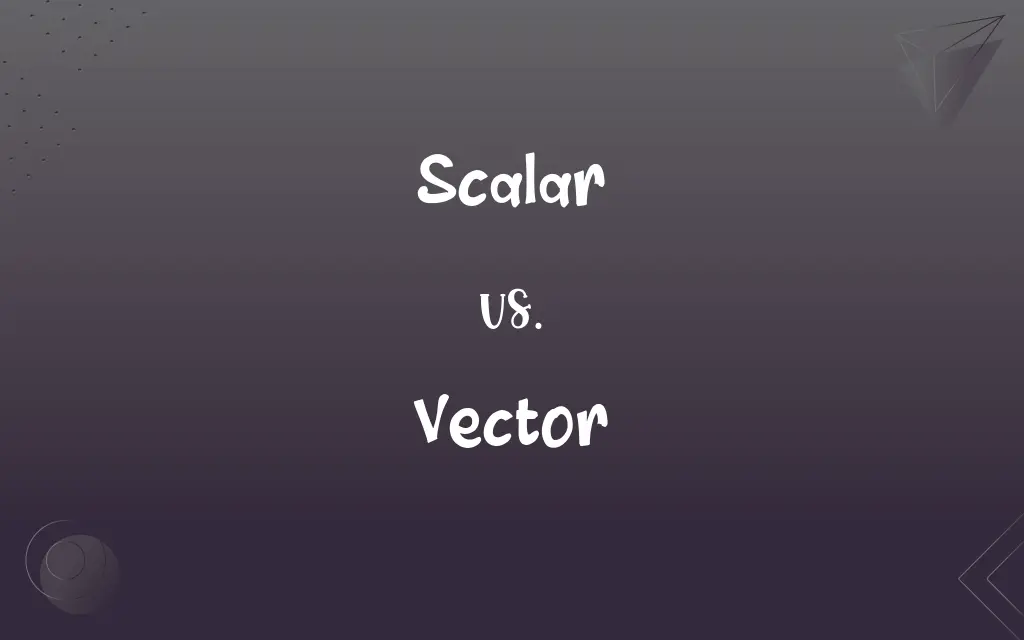Scalar vs. Vector: What's the Difference?
Edited by Aimie Carlson || By Harlon Moss || Updated on October 20, 2023
Scalar has only magnitude; vector has both magnitude and direction.

Key Differences
In physics, understanding the difference between scalar and vector quantities is crucial. A scalar is a quantity that is characterized by only its magnitude. For instance, mass or temperature, which can be described by a single number, are scalar quantities. Conversely, a vector is a quantity that possesses both magnitude and direction.
When discussing scalar quantities, it's notable that they provide a simple numerical value. For instance, when saying the temperature is 75°F or an object has a mass of 10 kg, these are scalar values. On the other hand, vectors require both a numerical value and a direction. If you mention a force of 5 Newtons, to classify it as a vector, a direction must be stated, such as "5 Newtons to the east."
Scalars can be easily added, subtracted, multiplied, or divided. If you have two lengths, 5 meters and 3 meters, their scalar sum is 8 meters. Vectors, however, require vector addition, often using geometric or mathematical techniques. If you have two displacements, one of 5 meters north and another of 3 meters east, the resultant vector would be calculated using the Pythagorean theorem.
It's also vital to understand that scalar quantities are invariant under coordinate rotations. This means if you change your point of view or rotate your reference frame, scalars remain unchanged. Vectors, in contrast, might appear different under rotations, as their components can change depending on the observer's perspective.
Many operations in physics and mathematics can convert scalars to vectors and vice versa. For instance, the gradient of a scalar field gives a vector field. Conversely, the divergence of a vector field results in a scalar.
ADVERTISEMENT
Comparison Chart
Definition
A quantity with only magnitude.
A quantity with both magnitude and direction.
Example
Temperature, Mass.
Force, Velocity.
Addition/Subtraction
Simple arithmetic.
Requires vector addition techniques.
Behavior under Rotation
Invariant (remains unchanged).
Can change (components vary).
Derived from
Can be derived from vector (e.g., magnitude of a vector).
Can be derived from scalar (e.g., gradient of scalar field).
ADVERTISEMENT
Scalar and Vector Definitions
Scalar
A magnitude without spatial orientation.
The weight of an apple, in grams, is a scalar.
Vector
A quantity possessing magnitude and direction.
The wind blows at 10 mph to the north, making it a vector.
Scalar
A numerical value without direction.
The temperature today is 85°F, a scalar value.
Vector
Represents both how much and where.
The displacement vector from home to school shows both distance and direction.
Scalar
A single number representing a quantity.
The distance from New York to Los Angeles, in miles, is a scalar.
Vector
A directed line segment in space.
The airplane's velocity vector indicates it's flying southeast.
Scalar
A quantity with only magnitude.
The speed of the car, 60 mph, is a scalar.
Vector
A physical quantity defined in a coordinate system.
The gravitational vector points toward the center of the Earth.
Scalar
A physical quantity that isn't direction-dependent.
The energy stored in a battery is a scalar.
Vector
An arrow with both length and direction.
The force applied on the box is 5 Newtons eastward, a vector.
Scalar
A quantity, such as mass, length, or speed, that is completely specified by its magnitude and has no direction.
Vector
A quantity, such as velocity, completely specified by a magnitude and a direction.
Scalar
(Mathematics) A number, numerical quantity, or element in a field.
FAQs
What's a common example of a vector?
A force, like 10 Newtons pushing north, is a vector.
What is a scalar?
A scalar is a quantity defined only by its magnitude.
How do you add scalar quantities?
Scalars are added using simple arithmetic.
Can vectors appear differently to different observers?
Yes, the components of a vector might change based on the observer's perspective.
What's the result of multiplying two vectors?
The result can be a scalar (dot product) or another vector (cross product), depending on the operation.
How does a vector differ from a scalar?
A vector has both magnitude and direction, while a scalar has only magnitude.
Does a scalar change with the observer's perspective?
No, scalar quantities remain the same regardless of the observer's viewpoint.
Can you multiply scalars and vectors?
Yes, multiplying a vector by a scalar changes the vector's magnitude but not its direction.
What's the importance of vectors in physics?
Vectors are crucial for representing quantities that have both magnitude and direction, like force or velocity.
Is speed a scalar or vector?
Speed is a scalar; it's the magnitude of the velocity vector.
How is direction represented in a vector?
Direction can be represented using angles, cardinal directions, or coordinate components.
Can vectors be represented graphically?
Yes, vectors are often represented as arrows with length and direction on coordinate systems.
How do you subtract vectors?
By adding the negative of one vector to the other, considering both magnitudes and directions.
Can you provide an example of a scalar?
Yes, the weight of an object, say 10 kg, is a scalar.
Is adding vectors the same as scalars?
No, vectors require vector addition techniques considering both magnitudes and directions.
Can a scalar be derived from a vector?
Yes, the magnitude of a vector is a scalar.
Are all numbers scalars?
Not necessarily. While all scalars are numbers, not all numbers are scalars in a specific context.
Do scalars have units?
Yes, scalars have units, like meters for length or kilograms for mass.
Why are vectors essential in engineering and science?
Vectors provide a comprehensive way to represent and analyze quantities that are directionally dependent, like forces or electric fields.
Is velocity a scalar or vector?
Velocity is a vector because it has both speed (magnitude) and direction.
About Author
Written by
Harlon MossHarlon is a seasoned quality moderator and accomplished content writer for Difference Wiki. An alumnus of the prestigious University of California, he earned his degree in Computer Science. Leveraging his academic background, Harlon brings a meticulous and informed perspective to his work, ensuring content accuracy and excellence.
Edited by
Aimie CarlsonAimie Carlson, holding a master's degree in English literature, is a fervent English language enthusiast. She lends her writing talents to Difference Wiki, a prominent website that specializes in comparisons, offering readers insightful analyses that both captivate and inform.































































